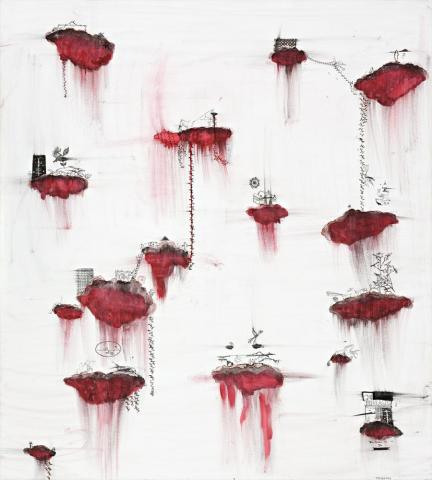TAPUAKIAGA, 2001
JOHN PULE
oil, ink and enamel on canvas
200.0 x 180.0 cm
signed, dated and inscribed lower right: John Puhiatau Pule 2001 / TAPUAKIAGA
Gow Langsford Gallery, Auckland, New Zealand
Private collection, Brisbane
John Pule: Recent Paintings, Gow Langsford Gallery, Sydney, 2003
Born in Niue in 1962 and emigrating to New Zealand at the age of two, esteemed poet and novelist John Pule first gained international recognition as an artist during the early nineties with his large unstretched canvases which, inspired by the aesthetics of traditional Niuean bark-cloth painting (hiapo), intertwine his own deeply personal experiences with contentious contemporary issues of colonialism and Christianity in the Pacific. Invariably employing a grid-like format which divided the canvas into rectangular cells, the aptly named 'hiapo paintings' featured a bewildering variety of imagery from abstract geometrical patterns to comic strip-like religious narratives and a plethora of hybrid creatures, humans and objects (some immediately recognisable, others derived from Niuean mythology or his imagination). Richly inventive and dynamic, such compositions revealed Pule as a highly original artist straddling several cultures in his underlying concerns with identity and migration, colonisation and the destruction of indigenous culture. Although strongly evocative of the Pacific however, his art was recognised as being at once more universal, more historical and more political than his Polynesian peers, akin rather to the important New Zealand artist of Maori descent, Ralph Hotere (1931 - 2013), who often engaged with international struggles from South Africa to Palestine. Extolling the searing individuality of Pule's voice, Nicholas Thomas asserts, he has 'no precedent in either traditional Polynesian art or modern Western genres'.At the dawn of the new millennium, Pule daringly abandoned this hiapo-grid idiom to embark instead upon the radically different 'cloud paintings', exemplified magnificently here by Tapuakiaga, 2001. His most celebrated achievement to date, the series invariably features surreal cloudscapes where rust red (or green) clouds of variable size, number and distribution, are surmounted by miniscule black-ink drawings detailing a proliferation of figures and forms: as Garrett elaborates, 'hybrid bird-like lizards, botanical motifs, birds, the Christian cross, Pacific church buildings, aeroplanes, broken aeroplanes mounted by two-headed monsters, ambulances, decapitated heads, fantastical creatures breathing fire, skulls, sex acts, island silhouettes ...'Indeed, in a manner reminiscent of the heterogeneous visions of Netherlandish proto-surrealist Hieronymus Bosch, many of the characters between and atop clouds are dismembered and calamities seem to be unfolding everywhere. Often linking the clouds are huge precarious ladders and falling tendrils of the ti mata alea (Cordyline tree), believed in Niuean culture to be the plant from which human life evolved. Symbolising the origins of his people, the flowering vines also bear strong personal significance for Pule whose family brought native Niuean plants with them to New Zealand to establish in the soil of their new home - an attempt to find anchorage that resonates throughout his art.
Although mourning a loss of cultural identity both for himself and the wider Pacific community, such works resist any overt postcolonial statement. Rather Pule's allusions to the dislocation and pain caused by migration and amalgamation with Western beliefs and society are always subtle and executed with ironic control; as David Eggleton elucidates, 'His paintings are miniature museums of ethnology ... Now and again, there is rupture and erasure, rubbing, smearing, blotting, but all done with delicacy and finesse.Similarly, that Pule constructs his bloody skyscapes from the view of aeroplanes - sites and instruments of global terror since 11 September 2001 - suggests a meditation upon this new era of international conflict and violence. Yet as elsewhere within his oeuvre, such condemnation of humanity's capacity for meaningless abuse is inevitably counterbalanced by a sense of optimism and insistence upon empathy; as the artist poignantly muses, 'I chose clouds and the sky because they feature so powerfully in the Bible. The sky is second only to the sea as a place that fills my imagination with awe. I see this space as a sort of backdrop to a place that is ideal, you know, a place that is full of metaphors for social change.'
1. Thomas, N., Possessions, Indigenous Art/Colonial Culture, Thames and Hudson, London, 1999
2. Garrett, R., 'Walking with Letters: Michael Parekowhai, John Reynolds, John Pule,' Artlink, vol. 27, no.1, 2007, pp. 46-49
3. Eggleton, D., 'John Pule and the Psychic Territory of Polynesia', Art New Zealand, 2001, p. 65
4. Pule cited in Durrant, J., 'Odes of a Restless Spirit: John Pule', Art Asia Pacific, vol. 67, March/April 2010, pp. 86-91
VERONICA ANGELATOS
